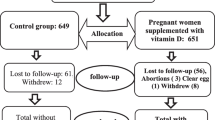Abstract
Pregnancy anemia and pregnancy-induced hypertension (PIH) are common and potentially dangerous disorder in human pregnancy, and nutritional status of pregnant women is one of the leading causes. Chlorella contains large quantities of folate, vitamin B-12 and iron, and can help improve anemia and hypertensive disorder. Our objective was to investigate the preventive effects of Chlorella supplement on pregnancy anemia and PIH in Japanese pregnant women. A total of 70 pregnant women were placed into the control group (n = 38) or the Chlorella group (n = 32). The subjects in the Chlorella group were supplemented daily from 12th–18th wk of gestation until delivery with 6 g of Chlorella supplement. The proportion of anemic (hemoglobin level < 11 g/dL) subjects in the Chlorella group were significantly lower compared with the control group at the second and third trimesters. Additionally, in the Chlorella group, the incidences of proteinuria and edema, signs of PIH, were significantly lower during the third trimester. These results suggest that Chlorella supplementation significantly reduces the risk of pregnancy associated anemia, proteinuria and edema. Chlorella supplement may be useful as a resource of natural folate, vitamin B-12 and iron for pregnant women.
Similar content being viewed by others
Abbreviations
- IL:
-
interleukin
- iNOs:
-
inducible nitric oxide synthetase
- NF-κB:
-
nuclear factor of κB
- NO:
-
nitric oxide
- PIH:
-
pregnancy-induced hypertension
- RDA:
-
recommended daily allowance
- Th1:
-
T-helper-1
- Th2:
-
T-helper-2
References
World Health Organization (1992) The prevalence of anemia in women: a tabulation of available information, 2nd edn. World Health Organization, Geneva
Hercberg S, Galan P (1992) Nutritional anaemias. Baillieres Clin Haematol 5:143–168
Van den Broek NR, Letsky EA (2000) Etiology of anemia in pregnancy in South Malawi. Am J Clin Nutr 72:247S–256S
Centers for Disease and Prevention (1992) Recommendations for the use of folic acid to reduce the number of cases of spina bifida and other neural tube defects. MMWR 41:1–8
Kusumi E, Matsumura T, Yuji K, Kami M, Shoji M, Endou S, Yoneyama A, Kishi Y, Shibata T, Murashige N, Hamaki T (2006) Prevalence of anemia among healthy women in 2 metropolitan areas of Japan. Int J Hematology 84:217–219
MRC Vitamin Study Research Group (1991) Prevention of neural tube defects: results of the medical research council vitamin study. Lancet 338:131–137
Sumiyoshi Y (2002) Folic acid and spondyloschisis. Spine Spinal Cord 15:825–832 (in Japanese)
Sumiyoshi K, Ikenoue T (2007) Our management of pregnancy induced hypertension. Obstetrical Gynecological Therapy 94:1104–1107 (in Japanese)
Hernandez-Diaz S, Werler MM, Louik C, Mitchell AA (2002) Risk of gestational hypertension in relation to folic acid supplementation during pregnancy. Am J Epidemiol 156:806–812
Tamura E, Nishihara A, Isobe S, Matsuno N (1959) Nutrition studies on Chlorella. Jpn J Nutr 17:19–20 (in Japanese)
Fujiwara Y, Hirakawa K, Sinpo K (1990) Effect of long-term administration of Chlorella tablets on hyperlipemia. J Jpn Nutr Food Sci 43:167–173 (in Japanese)
Tanaka K, Konishi K, Himeno K, Taniguchi K, Nomoto K (1984) Augmentation of antitumor resistance by a strain of unicellular green algae, Chlorella vulgaris. Cancer Immunol Immunother 17:90–94
Matsuura E, Nemoto T, Hozumi H, Izumi K, Saito Y, Ishida H, Fukimbara T, Kawahara H (1991) Effect of Chlorella on rats with iron deficient anemia. Kitasato Arch Exp Med 64:193–204
Inoue K, Mukaiyama Y, Oka H, Sansawa H (1995) Clinical effects of Chlorella in hypertensive men. J Jpn Nutr Food Sci 48:485–489 (in Japanese)
Ministry of Health, Labour and Welfare Japan (2007) National health and nutrition examination survey 2004. Dai-ichi Shuppan, Tokyo (in Japanese)
Juarez-Vazquez J, Bonizzoni E, Scotti A (2002) Iron plus folate is more effective than iron alone in the treatment of iron deficiency anemia in pregnancy: a randomized double blind clinical trial. BJOG 109:1009–1014
Herbert V (1967) Biochemical and hematological lesions in folic acid deficiency. Am J Clin Nutr 20:562–572
Hannon-Fletcher MP, Armstrong NC, Scott JM, Pentieva K, Bradbury I, Ward M, Strain JJ, Dunn AA, Molloy AM, Kerr MA, McNulty H (2004) Determining bioavailability of food folate in a controlled intervention study. Am J Clin Nutr 80:911–918
Gujska E, Majewska K (2005) Effect of baking process on added folic acid and endogenous folates stability in wheat and rye breads. Plant Foods Hum Nutr 60:37–42
Kobayashi T (2003) Study on pathogenesis of preeclampsia: Endothelial dysfunction related to hypercoagulation, hyperactivity of sympathetic nerves, vasospasms and hypercoagulative mice models. Acta Obst Gynaec Jpn 55:851–862 (in Japanese)
Roggensak AM, Zhang Y, Davidge ST (1999) Evidence for peroxynitrite formation in the vasculature of women with preeclampsia. Hypertension 33:83–89
Park JY, Cho HY, Kim JK, Noh KE, Yang JR, Ahn JM, Lee MO, Song YS (2005) Chlorella dichloromethane extract ameliorates NO production and iNOS expression through the down-regulation of NF kappa B activity mediated by suppressed oxidative stress in RAW 264.7 macrophages. Clin Chim Acta 351:185–196
Saito S, Sakai M (2003) Th1/Th2 balance in preeclampsia. J Reprod Immunol 59:161–173
Ewart HS, Bloch O, Girouard GS, Kralovec J, Barrow CJ, Ben-Yehudah G, Suárez ER, Rapoport MJ (2007) Stimulation of cytokine production in human peripheral blood mononuclear cells by aqueous Chlorella extract. Planta Med 73:762–768
Acknowledgments
Sun Chlorella A tablets used in this study were provided without charge by Sun Chlorella Corp. (Kyoto, Japan).
Author information
Authors and Affiliations
Corresponding author
Rights and permissions
About this article
Cite this article
Nakano, S., Takekoshi, H. & Nakano, M. Chlorella pyrenoidosa Supplementation Reduces the Risk of Anemia, Proteinuria and Edema in Pregnant Women. Plant Foods Hum Nutr 65, 25–30 (2010). https://doi.org/10.1007/s11130-009-0145-9
Published:
Issue Date:
DOI: https://doi.org/10.1007/s11130-009-0145-9




